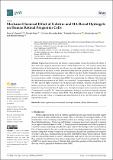Mechano-Chemical Effect of Gelatin- and HA-Based Hydrogels on Human Retinal Progenitor Cells
Author(s)
Dromel, Pierre C.; Singh, Deepti; Alexander-Katz, Alfredo; Kurisawa, Motoichi; Spector, Myron; Young, Michael; ... Show more Show less
Downloadgels-09-00058.pdf (5.014Mb)
Publisher with Creative Commons License
Publisher with Creative Commons License
Creative Commons Attribution
Terms of use
Metadata
Show full item recordAbstract
Engineering matrices for cell therapy requires design criteria that include the ability of these materials to support, protect and enhance cellular behavior in vivo. The chemical and mechanical formulation of the biomaterials can influence not only target cell phenotype but also cellular differentiation. In this study, we have demonstrated the effect of a gelatin (Gtn)—hyaluronic acid (HA) hydrogel on human retinal progenitor cells (hRPCs) and show that by altering the mechanical properties of the materials, cellular behavior is altered as well. We have created an interpenetrating network polymer capable of encapsulating hRPCs. By manipulating the stiffness of the hydrogel, the differentiation potential of the hRPCs was controlled. Interpenetrating network 75 (IPN 75; 75% HA) allowed higher expression of rod photoreceptor markers, whereas cone photoreceptor marker expression was found to be higher in IPN 50. In vivo testing of these living matrices performed in Long–Evans rats showed higher levels of rod photoreceptor marker expression when IPN 75 was injected versus IPN 50. These biomaterials mimic biological cues that are required to simulate the dynamic complexity of natural retinal ECM. These hydrogels can be used as a vehicle for cell delivery in vivo as well as for expansion and differentiation in an in vitro 3D system in a highly reproducible manner.
Date issued
2023-01-11Department
Massachusetts Institute of Technology. Department of Materials Science and EngineeringPublisher
Multidisciplinary Digital Publishing Institute
Citation
Gels 9 (1): 58 (2023)
Version: Final published version